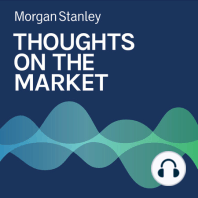3 min listen

Mike Wilson: Credit Crunch in the U.S Equity Markets
Mike Wilson: Credit Crunch in the U.S Equity Markets
ratings:
Length:
4 minutes
Released:
Apr 17, 2023
Format:
Podcast episode
Description
While some investors may be cheering due to softer than expected inflation data, revenues may begin to disappoint in the face of a credit crunch brought on by recent banking stress.----- Transcript -----Welcome to Thoughts on the Market. I'm Mike Wilson, Chief Investment Officer and Chief U.S. Equity Strategist for Morgan Stanley. Along with my colleagues, bringing you a variety of perspectives, I'll be talking about the latest trends in the financial marketplace. It's Monday, April 17th, at 11:30 a.m. in New York. So let's get after it. A month ago, when the banking stress first surfaced, my primary takeaway for U.S. equity markets was that it would lead to a credit crunch. Given our already well below consensus outlook for corporate earnings, it simply gave us more confidence in that view. Fast forward to today and the data suggests a credit crunch has started. More specifically, they show the biggest two week decline in lending by banks on record as they simultaneously sell mortgages and treasuries at a record pace to offset deposit flight. In fact, since the Fed began raising rates a year ago, almost $1 trillion in deposits have left the banking system. Throw in the already tight lending standards and it's no surprise credit growth is shrinking. If that isn't enough, last week, the latest small business survey showed that credit availability had its biggest drop in 20 years, while interest costs are at a 15-year high. There's a passage in Ernest Hemingway's The Sun Also Rises, in which a character is asked how he went bankrupt. "Two ways", he answers. "Gradually, then suddenly". This is a good description of recent bank failures. The losses from long duration Treasury holdings and concentrated deposit risk built up gradually over the past year and then suddenly accelerated, leading to the surprising failures of two large and seemingly safe banks. In hindsight, these failures seem predictable given the speed and magnitude of the Federal Reserve's rate hikes, some regrettable regulatory treatment of bank assets and concentrated deposits from corporates. Nevertheless, most did not see the failures coming, which begs the question of what other surprises may be coming from the Fed's abrupt monetary policy adjustment? In contrast to what we expected, the S&P 500 and Nasdaq have traded well since these bank stresses appeared. However, small caps, banks and other highly leveraged stocks have traded poorly as the market leadership turned more defensive and in line with our sector and style recommendations. Our contention is that the major averages are hanging around current levels due mostly to their defensive and high quality characteristics. However, that should not necessarily be viewed as a signal that all is well. On the contrary, the gradual deterioration in the growth outlook continues, which means even these large cap indices are at risk of a sudden fall like those that we have witnessed in the regional banking and small cap indices. The analogy with Hemingway's poetic description of bankruptcy can extend to the earnings growth deterioration observed over the past year. Until now, the decline in earnings estimates for the S&P 500 has been steady and gradual. Since peaking in June of last year, the forward 12 month bottoms up consensus earnings per share forecast for the S&P 500 has fallen at a rate of approximately 9% per annum, which is not severe enough for equity investors to demand the higher equity risk premium we think they should. Further comforting investors is the consensus earnings forecast that implies first quarter will be the trough rate of change for S&P 500 earnings per share. This is a key buy signal that we would normally embrace, if we believed it. Instead, if we are right on our well below consensus earnings forecast, the rate of decline in these estimates should increase materially over the next few months as revenue growth begins to disappoint. To date, most of the disappointment in earnings has been a
Released:
Apr 17, 2023
Format:
Podcast episode
Titles in the series (100)
Mike Wilson: How Confident Are U.S. Businesses in the Economy? by Thoughts on the Market